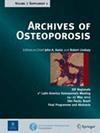Role of gestational age and intrauterine growth on bone mass in adolescents: findings from a Brazilian Birth Cohort Study
IF 2.8
3区 医学
Q2 ENDOCRINOLOGY & METABOLISM
引用次数: 0
胎龄和宫内生长对青少年骨量的影响:来自巴西出生队列研究的发现。
成年期骨质疏松症往往起源于生命早期,有些形式可以通过在新生儿期和儿童期适当注意骨骼健康来预防,特别是在早产儿或宫内生长受限的情况下。目的:探讨胎龄、宫内生长与青少年骨量的关系。方法:利用2004年Pelotas出生队列的数据,采用双能x线吸收仪测定15岁时的结果密度(aBMD)和含量(BMC)。感兴趣的暴露是:早产(结果:包括1494名参与者。在全校正模型中,包括青少年身高,早产女性股骨颈aBMD低于足月(β - 0.04 g/cm2;95% ci - 0.07; - 0.01;P = 0.012)和妊娠≥42周出生者(β - 0.07 g/cm2;95% ci - 0.13; - 0.01;p = 0.026)。妊娠≤36周和37-41周出生的男性BMC股骨颈少于妊娠≥42周出生的男性(β - 0.8 g;95% CI - 1.4, - 0.2和β - 0.8 g;95% CI分别为- 1.4和- 0.2)。LGA雌性小鼠全身BMC增加约100 g (β 97.3 g;95% ci 20.5;174.1;p = 0.022)。在3个月时接受纯母乳喂养的SGA女性的BMD(腰椎和股骨颈)和BMC高于未接受纯母乳喂养的女性。结论:早产和宫内发育限制也可影响青春期发育。
本文章由计算机程序翻译,如有差异,请以英文原文为准。
求助全文
约1分钟内获得全文
求助全文
来源期刊

Archives of Osteoporosis
ENDOCRINOLOGY & METABOLISMORTHOPEDICS -ORTHOPEDICS
CiteScore
5.50
自引率
10.00%
发文量
133
期刊介绍:
Archives of Osteoporosis is an international multidisciplinary journal which is a joint initiative of the International Osteoporosis Foundation and the National Osteoporosis Foundation of the USA. The journal will highlight the specificities of different regions around the world concerning epidemiology, reference values for bone density and bone metabolism, as well as clinical aspects of osteoporosis and other bone diseases.
 求助内容:
求助内容: 应助结果提醒方式:
应助结果提醒方式:


